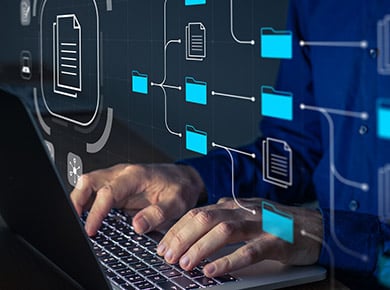Why the digital employee experience (DEX) is a top priority
Find out why company leaders are looking to the future of the digital workspace by investing in the digital experience.
November 10, 2021 | By Bryan Van Wyhe

This era has been dubbed the greatest work experiment in history. As leaders discuss what’s next in the future of work, companies are investing in workplace transformation. Learn why the digital employee experience is a top priority.
What is the digital employee experience?
The digital employee experience (DEX) describes how employees engage workplace technology to do their jobs. DEX may not be uniform across an entire company.
Each department may use different digital tools to complete their work. And still, every single employee has a DEX.
IT support teams don’t have a full view of their DEX
From slow internet to issues with company data, bad tech slows down workers. The Brain on Tech study uncovered that employees working with good tech can achieve 37% more in a day. Conversely, the study found that when faced with bad tech employee productivity can drop by over 30%.
Many IT leaders can't see the full scope of their DEX. Why? Because workers don’t report or seek help for every tech issue that slows them down. The disconnect can be a result of bad support experiences in the past. Or worse, no confidence in IT support's ability to fix the problem.
How can company leaders tackle these problems? Empower end users with self-service tools. Use self-healing technologies to analyse patterns and proactively resolve issues. But first comes investing in digital workplace solutions.
Technology impacts more than remote workspace productivity
Employees experiencing tech issues face more than just lost output. A stalled employee is more likely to become a frustrated, disengaged and burnt-out employee.
What’s the good news? Research from Forrester, a research and advisory company, finds companies delivering a great employee experience through technology have better employee engagement that drives business outcomes.
A revamped online work environment leads to less time requesting support and more time for big ideas. An effortless end-user experience frees up employees to connect with their team and build creative solutions.
DEX is a big factor in employee engagement
In the war for talent, an employer’s brand is vital—even after the disruption from the COVID-19 pandemic. According the Employer Branding Agency Universum’s Employer Branding NOW 2021 Report, employer branding and recruitment budgets are up by more than 10%.
When crafting an engaging work environment, employers can’t ignore workplace technology. Research from Forrester reveals in their Employee Experience Index that technology accounts for 30% of EX.
According to Harvard Business Review, investing in the digital employee experience can yield great results. Think: happier employees, increased productivity, better business outcomes and even happier customers. With such a clear impact on employee engagement, companies can't wait to improve the digital workplace.
Organizations are forecast to spend nearly $656 billion on future of work technologies in 2021.
The digital employee experience is the remote employee’s only experience
In the new world of work from anywhere, technology defines our interactions with our team, work and company culture. For example, the remote onboarding experience sets the tone of the culture and values of a company. Are your core enterprise applications helping HR create a smooth onboarding process? Does a new hire have access to the appropriate applications, data and tools on day one?
Consider the ROI for improving the onboarding process and digital work environment. A report commissioned by Glassdoor revealed that companies with a strong onboarding process improved new hire retention by 82% and boosted productivity by over 70%. With on-demand learning and self-help technology, new hires became proficient more quickly.
Set new hires up for success. The benefits? Improved retention, productivity and business value.
Employees demand work flexibility
The COVID-19 pandemic prompted a shift to remote work. In many cases, employees have enjoyed the flexibility of a work-from-home or work-from-anywhere model. According to the Gartner 2021 Digital Worker Experience Survey, workers will demand flexibility in work location and work hours moving forward.
How can employers make remote or hybrid work models sustainable? Build a digital workplace that enables work anywhere, anytime, on any device.
Employees expect their experience to measure up to consumer digital experience
When brick-and-mortar locations closed in early 2020, consumer brands had to pivot. Brands upgraded digital experiences to win business online. Easy-to-use apps and personalisation kept consumers shopping. These investments preserved—if not improved—brand loyalty.
Few employers have kept pace with consumer brands in this space. And yet, employees expect a digital experience that rivals their daily experiences as consumers. Think: effortless and personalised, tailored to specific job roles and functions. Younger generations entering the workforce demand their workplace technology match their digital literacy.
The future of work is now
Regardless of your return-to-office plan, the digital workspace is here to stay. While some workplace initiatives prompted by the pandemic may wind down in the future, the digital workplace remains. Even in-office employees will interact with a digital workplace platform from now on. Use technology to build an online work environment that empowers and energises employees.
Reshaping the world of work
IT and company leaders are investing in workplace transformation to improve productivity and the digital employee experience. Read more in TEKsystems latest issue of Transform Your World.